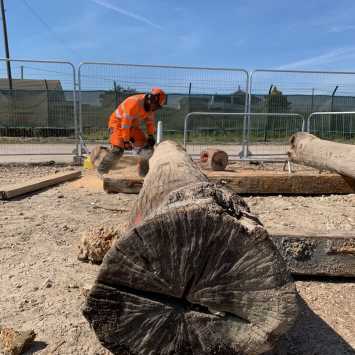Focus on-site requirements - Dymchurch Flood Defence - Life in Lockdown - Part 2
Following lockdown in March, all of our planned training was put on hold. We received a welcome phone call from Jenny at Mackley Civil & Marine Engineers urgently requesting chainsaw maintenance and cross-cutting training on-site at the Environmental Agency Flood Defence Contract in Romney Marsh.
A breach to the flood wall earlier in the year proved the significance of this essential work. Romney Marsh is below sea level and is protected by shingles and a barrier that prevents flooding at high tide. Groynes wooden structures that run at 90° to the sea limit drift and movement of shingles. At Romney Marsh, these are around 80 years old and have deteriorated over time, diminishing the protection for the sea wall.
Mackley is replacing some of these structures, and chainsaw work is required to prepare new material for construction and occasionally for demolition - albeit most is done by machine. After some consideration, the Lantra Awards ITA in Chainsaw Maintenance & Crosscutting was selected as being both cost and time effective.
This 2-day course is ideal for those needing to use chainsaws for basic crosscutting type tasks as a part of their role, and where there is no requirement to progress onto further advanced units, e.g. felling.
Delivering on-site training can be a lottery, but here, due to the fine weather and adequate on-site resources, it worked well. This grants the apparent advantages of tree training in the exact context of the employee’s work, which for this contract was slightly unusual. As a bonus, the staff did not have to travel.
- Large conference room for theory and review
- Outdoor maintenance area allowed plenty of space
- Cross-cutting area segregated in yard
- Larger material than ideal for cutting but machine handling available
In addition, due to the Coronavirus restrictions, the site had been specified with more office and welfare units than usual allowing plenty of space for the site based employees. We were able to supply individual maintenance kits and maintained a reasonable distance when doing the maintenance sessions outside.
Coronavirus – additional measures
- Ordered more site units – spaced out
- Trainees used and maintained their own chainsaw
- Separate kits for maintenance
- Kept our distance
The client’s chainsaws for this work were Stihl 362s with 18” guide bars fitted with both regular Stihl full chisel and tungsten tipped chains, offering significantly increased good cutting performance between sharpening. These are larger than we would typically recommend, but due to the more extensive material to be cut a regular 15” 50cc saw might have been a little underpowered.
For crosscutting practice, we used the groyne braces, which were oak stems that had been in the sea environment for around 80 years. They were contaminated with sand, shingle and steel from various fixings. We cleaned the majority of the debris and marked obvious non-removable pins and stones with bright forestry spay before crosscutting. Because they were somewhat heavy, the onsite JCB load-all was required to set up and then reconfigure the crosscutting material throughout the sessions.
This material allowed an excellent test for the student’s assessment of tension and compression, cut accuracy, and because of the ingrained sand particles, there was plenty of repeat sharpening needed through the session.
The main groyne structure comprising posts and boards is made from a Green Heart, a Guyanan tropical hardwood that is highly durable for marine structures. There was a chance to see the engineering work in progress during a lunch break.
When helping clients decide on whether on-site training is the right option, we advise that we need the following:
- Classroom - this is often better as the workshop area is very basic. Used for briefing trainees, filling our paperwork and introducing topics such as risk assessment, health & safety legislation and looking at clean personal protective equipment (PPE).
- Workshop - with plenty of bench space and vices for chainsaw sharpening. Good lighting, heated for the colder weather and with enough space for students to spread out and see instructor demonstrations.
- Work area specific to the course - safe away from public areas and other hazards such as vehicle movements, ideally away from areas where noise could be an intrusion. Easily signed & guarded.
- Sufficient material to cut - in this case, 5-6 lengths per trainee or sufficient trees to fell depending on the course
It was undoubtedly enjoyable carrying out the training at this site and seeing the work Mackley’s are undertaking.
We will be developing a checklist against which clients can match their onsite facilities and resources to ensure training delivery is as good as it can be.


